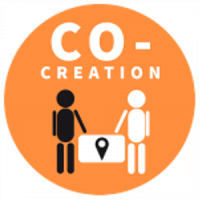Complex, Meidoornkade 22
3992 AE Houten
0343 528 040
3992 AE Houten
0343 528 040

Co-creation is about synergy between interdependent professionals. It is a high performance way of collaboration, based on presence, agility and a seamless flow of ideas, information and activities.
The success strategy: Work together, be powerful and smart. We inspire each other and we proactively align towards achieving sustainable results. We can discuss this factor using the following success markers: Who knows what, Proactive alignment, Seamless flow, Inspire each other and Improve together

33% of all team members are aware of the knowledge and experience of others. This awareness enables group intelligence and the ability to solve challenging problems. Especially in multidisciplinairy teams this awareness is important and results from high quality interaction, communication and team learning.
Focus on people, purpose and overall goals. Establish an overview of the required expertise and your taks at hand.
These questions might trigger your awareness:
Use techniques for:

A survey among 500 + professionals shows that we are mostly dissatisfied (45% neutral, 38% dissatisfied) about well-timed and coherent alignment of activities. This lack of alignment costs extra energy (switching between tasks, starting up again) and blocks the flow of activities. In many cases the cause of poor alignment is a poor collectieve context or insufficient quality of communication.
Start with a proactive attitude. Use forward thinking to find actions or issues that interrelate with others.
Ask yourself:
Apply methods for:

Research shows that one of the biggest dissatisfiers in teamwork is the lack of a natural workflow. Waiting for others, who seem not to be able to complete their actions, reduces the task cohesion as well as the social cohesion in a group. It is mainly caused by an insufficient shared context or poor communication.
Balance, focus and alignment foster the experience a flow state. Balance is a personal feeling that arises from determination, setting the right priorities and a certain rhythm and regularity in the way we work and rest.
Awareness questions:
Use methods for

Reseach shows that opinions are devided ((27% unsatisfied, 28% satisfied). It is heavily depending on the context (type of work, social cohesion, culture) whether a high level of interaction and inspiration is a driving factor for successful outcomes. On the other hand however the lack of inspiration is the major cause of a communication shut down that triggers the break down of the social cohesion in the group.
Inspiration is the result of enjoying the work and having a sense of contributing to others. Being aware of your own purpose or experience sparks inspiration.
Awareness questions:
Foster openness in the team and spent sufficient time together in order to create a deeper level of understanding.
Create a culture of respect, appreciation and feedback.
Find answers to simple questions: What inspired you during our meeting? What energizes us?
Celebrate the ‘small achievements’ and appreciate the contribution of other team members.
Focus on purpose and contribution:

Survey results show that improving together is not the highest priority at work (31% satisfied, 45% neutral, 24% unsatisfied). Not everybody has a personal drive to improve in a team setting, but if the setting is right, this might stimulate the behaviour. High performing teams need professionals that are inspired by collective improvement to cope with the challenges ahead.
Most people find it easy to accept feedback for improvement when received within the context of a proper relationship and common goal.
An active attitude stimulates this context. You could ask yourself:
Ask others for feedforward (what do you feel I could improve in the future?)
Every team member has a unique way of working. Give feedback, find new ways and share expectations.
Use the closing of a meeting to learn together and find small improvements for the next meeting or conversation.
Set up reflection-meetings with others (customers, experts).
Rien van Leeuwen gaat in op basiscondities voor duurzame verandering.
Aan de hand van praktijk-cases verkennen we de barrières bij het bereiken van duurzame doelen op strategisch, tactisch en operationeel niveau. Denk hierbij aan bestaande structuren en opvattingen, maar ook aan het niet kunnen duiden van negatieve en positieve impact.
We delen onderling de best practices en interventies die anderen activeren. Uiteindelijk draait elke verandering om een andere manier van interactie.
Rien van Leeuwen gaat in op basiscondities voor duurzame verandering.
Aan de hand van praktijk-cases verkennen we de barrières bij het bereiken van duurzame doelen op strategisch, tactisch en operationeel niveau. Denk hierbij aan bestaande structuren en opvattingen, maar ook aan het niet kunnen duiden van negatieve en positieve impact.
We delen onderling de best practices en interventies die anderen activeren. Uiteindelijk draait elke verandering om een andere manier van interactie.